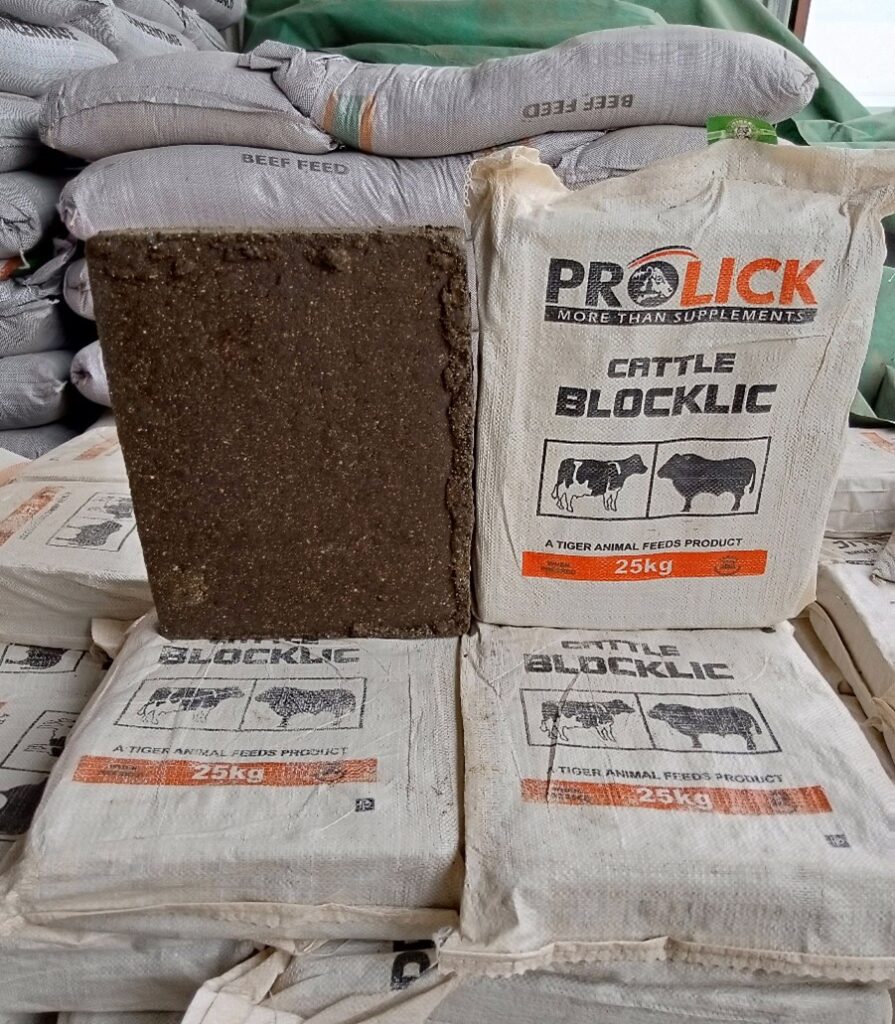Non-protein nitrogen (NPN) is a term used in animal nutrition to refer collectively to components such as urea, biuret, and ammonia, which are not proteins but can be converted into proteins by microbes in the ruminant animal’s stomach. In cattle, ruminal microbes can utilise NPN to synthesise proteins that can replace a portion of their total dietary protein requirements.
NPN can be very beneficial to the farmer by providing a cheaper but more effective source of dietary protein. NPN is ideal especially during the dry season when the pastures are poor and low in protein content. This means that despite the highly fibrous and poor-quality grasses available during the dry season, the animals can continue gaining weight and remain productive.
Sources of non-protein nitrogen and how they work
Prolick, a cattle lick block produced by Tiger Animal Feeds, is an excellent source of non-protein nitrogen because of the urea it contains.
When Prolick lick block is consumed, it provides the much-desired urea in the rumen for bacterial urease to dissolve and hydrolyse into ammonia. Then, further metabolism combines ammonia with carbon chains to form amino acids. Finally, the rumen micro-organisms metabolise and incorporate the amino acids into rumen microbial protein. These bacteria are later broken down and their microbial protein and vitamins absorbed by the animal in the intestines. Cattle can utilise NPNs to synthesise proteins that can replace a portion of their total dietary protein requirements.
Why should cattle farmers in Zambia consider Prolick as a source of protein?
Most pasture range in Zambia is not improved, hence it is of very poor quality, particularly in the dry season. It is low in the quantity of digestible protein, energy, minerals, and vitamins. It is not possible to meet all the nutritional requirements of the animals by basically allowing them to feed off the veld. The grasses normally contain less than two percent digestible crude protein in dry season, which means that supplementation must be provided just to maintain the weight of the animals throughout the dry periods of the year. Prolick as a source of non-protein nitrogen can help Zambian farmers by ensuring that they meet the protein needs of their livestock at the worst time of the year when pastures are low in quality as well as quantity.

Tiger Animal Feeds cattle block lick.
Benefits of Prolick to cattle
- The urea in Prolick will keep up activity by ensuring that rumen bacteria multiply, and hence more microbial crude protein is made available to the animal.
- The rumen bacteria are not only important in protein synthesis through the use of NPN, but will also help the animals to extract energy from the highly fibrous grasses that they must consume.
- Feed supplementation with Prolick will improve the survival rate and increase the roughage intake of cattle. It is also found to reduce body weight loss, improve birth weight of calves, reduce neonatal mortality, and lead to higher milk yields and calf growth rate. The urea in Prolick will enable the animals to survive during droughts.
- Prolick is a cost-effective way of ensuring that the animals can meet their protein requirements.
The safe use of non-protein nitrogen (urea)
Urea can be deadly if not used correctly! Ammonia poisoning will result from excessive consumption of sources of NPN or urea. Ammonia poisoning is acute and often rapidly fatal, with clinical signs including muscle tremors, abdominal pain, incoordination, respiratory distress, and recumbency followed by death. In order to use urea or any other NPN safely, there are several precautions the farmer needs to take note off:
- Tiger Animal feeds ensures the safe and effective use of urea by incorporating it into a cattle block lick. Prolick, a mineral block lick, should be used when the grass is dry. It supplies all the nutrients the animal needs. However, because of the urea present in the lick block, it should only be fed to cattle and notcto horses and game.
- The cattle lick should be kept out of rain because if the cattle drink the water with the dissolved urea, they will die of urea poisoning. Expected feed intake The expected feed intake is 400 to 600 g per animal, per day, when there is no fodder available and approximately 250 g per animal, per day when there is some fodder or grazing available.
- If you are using urea that has not been incorporated into a lick block, be sure that only one-third (1/3) of the total protein provided in the diet of the animal is the urea. The maximum quantity of urea that should be allowed to maintain growth in cattle during the dry season on the veld is 25 g per 100 kg live weight per day.
- In concentrate rations, the maximum allowance should be 3% of the complete mixture. But lower quantities are usually sufficient for production or fattening rations. The best utilisation of urea is achieved when there is a true source of protein in the mixture.
- Urea needs careful and thorough mixing when it is incorporated with other feed ingredients. This is because it is hygroscopic and absorbs water from the atmosphere. It then forms hard lumps which may be sufficiently large to kill an animal if consumed at once.
Please note:
Do not use urea in a concentrate mixture containing soya beans because soya beans contain enzymes urease which may speed up the breakdown of urea to ammonia and thus increase the chances of poisoning.
For more information on Prolick and the wide range of products and stock Tiger Feeds has, contact Barbara Mulonda Simbaya on (+26)096-920-2207, or send an e-mail to barbara.mulonda@tigerfeeds.com.zm.









